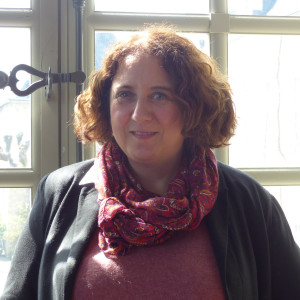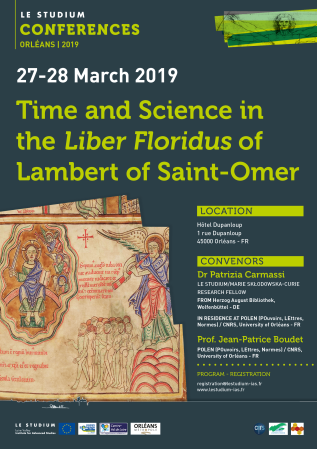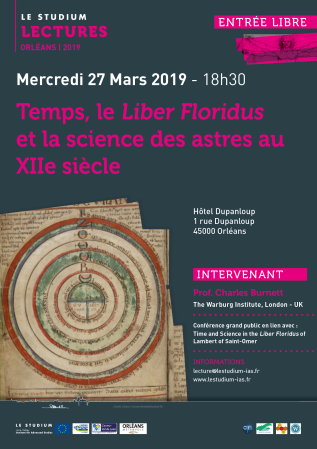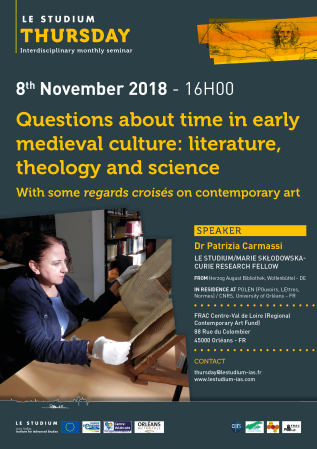Dr Patrizia Carmassi

LE STUDIUM / Marie Skłodowska-Curie Research Fellow
From
In residence at
POLEN (POuvoirs, LEttres, Normes) / CNRS, University of Orléans - FR
Host scientist
Prof. Jean-Patrice Boudet
PROJECT
Questions about time in early medieval culture: Literature, theology and science
This project contributes to recent research about time in the Middle Ages. It will deal with the concepts of time in early medieval sources (VIII-XII saec.), focusing on two particular fields: theological literature and science. In both cases the research corpus is based on manuscript sources and includes manuscripts preserved in Orléans that belong to the cultural heritage of the region Centre-Val de Loire. The aim is to investigate this corpus in order to understand which different concepts of time were used, whether distinct concepts of time coexisted in a specific period and culturally consistent milieu (e.g. the monastery of Fleury), and whether there were tensions and contradictions between different systems, notions and layers of time in various genres genres of theological and scientific writings and historical periods. It deals with the question of norm and transmission of knowledge, by analyzing, how older doctrines of time were perceived, adopted or challenged, and even transformed during the Middle Ages. The study will also improve the dialogue between disciplines, institutions and between historians and scientists by comparing research about time in modern scientific fields of research.
Publications
This article analyses the relationship of Pietro Bembo's Prose with the introductory Epistola of the Raccolta Aragonese and Cristoforo Landino's proemio to his Comento sopra la Comedia, with regard to their views of the previous vernacular tradition and in particular the more or less comparable paradigms applied to past literary history. The question of whether Bembo knew Poliziano's Epistola is investigated, and the similarities and dissimilarities between the different narratives concerning cultural development and the ways in which these narratives are elaborated in the three texts are evaluated.
Dans Codex and Material , les substances et matériaux pour la production et la conception d'un Codex, leur signification symbolique, esthétique, sensuelle ou historico-culturelle ainsi que la base technologique sont examinés dans douze contributions. Des auteurs internationaux reconnus traitent des éléments spécifiques du livre tels que la couverture et la police, la conception des pages et des livres ( mise en page, mise en livre) ainsi que les différentes fonctions de rôle et de codex pour la structure du texte et de l'image. D'autres sujets sont la réutilisation et la fragmentation du papier, du parchemin et du tissu comme preuve de réception contextuelle ; la conception et la perception de la couverture du livre ; l'approche tactile du Codex ; la tension entre matérialité avérée et matérialité imaginaire à l'aide de l'exemple de l'or ; les effets du rendu matériel vériste et de l'illusionnisme dans l'enluminure des livres ; la connexion au monde transcendant à travers l'expérience matérielle et les limites de la matérialité. De cette manière, le volume strictement thématique apporte une contribution importante au discours scientifique actuel et interdisciplinaire sur le côté matériel de la génération, du traitement esthétique et de la communication des connaissances.
In der neueren Forschung zur mittelalterlichen Schrift- und Buchkultur gilt dem Paratext in allen seinen Erscheinungen, von den Prologen zu den Rubriken, von den Glossen zu den Kolophonen, eine stetig wachsende Aufmerksamkeit. In diesem Band stehen die Seitenränder von mittelalterlichen Handschriften und frühneuzeitlichen Drucken im Mittelpunkt. Schriftliche und bildliche Ergänzung oder die geplante Disposition von Inhalten „am Rande“ werden als aufschlussreiche, bisher wenig erforschte Erschließungsinstrumente für Kulturtradition und Kommunikation analysiert und bewertet. Sie gelten als Zeugnisse von Lese- und Kommentierungspraktiken, von Rezeption und Überlieferung von Wissen. Sie können die Gedanken von einzelnen Lesern oder Schreibern reflektieren, aber auch komplexere Veränderungen in den visuellen Gestaltungsformen und –gewohnheiten in illuminierten Handschriften sowie ausgereifte Lernprogramme von ganzen Gemeinschaften wie dem Kloster Weißenburg im 9. Jahrhundert reflektieren. Neben einzelnen Essays und Falluntersuchungen vom Frühmittelalter bis zur Renaissance bietet der Band einen umfangreichen systematischen Einführungsbeitrag zu der Natur, den Formen und den Funktionen von Marginalien in der vormodernen Buchkultur.



